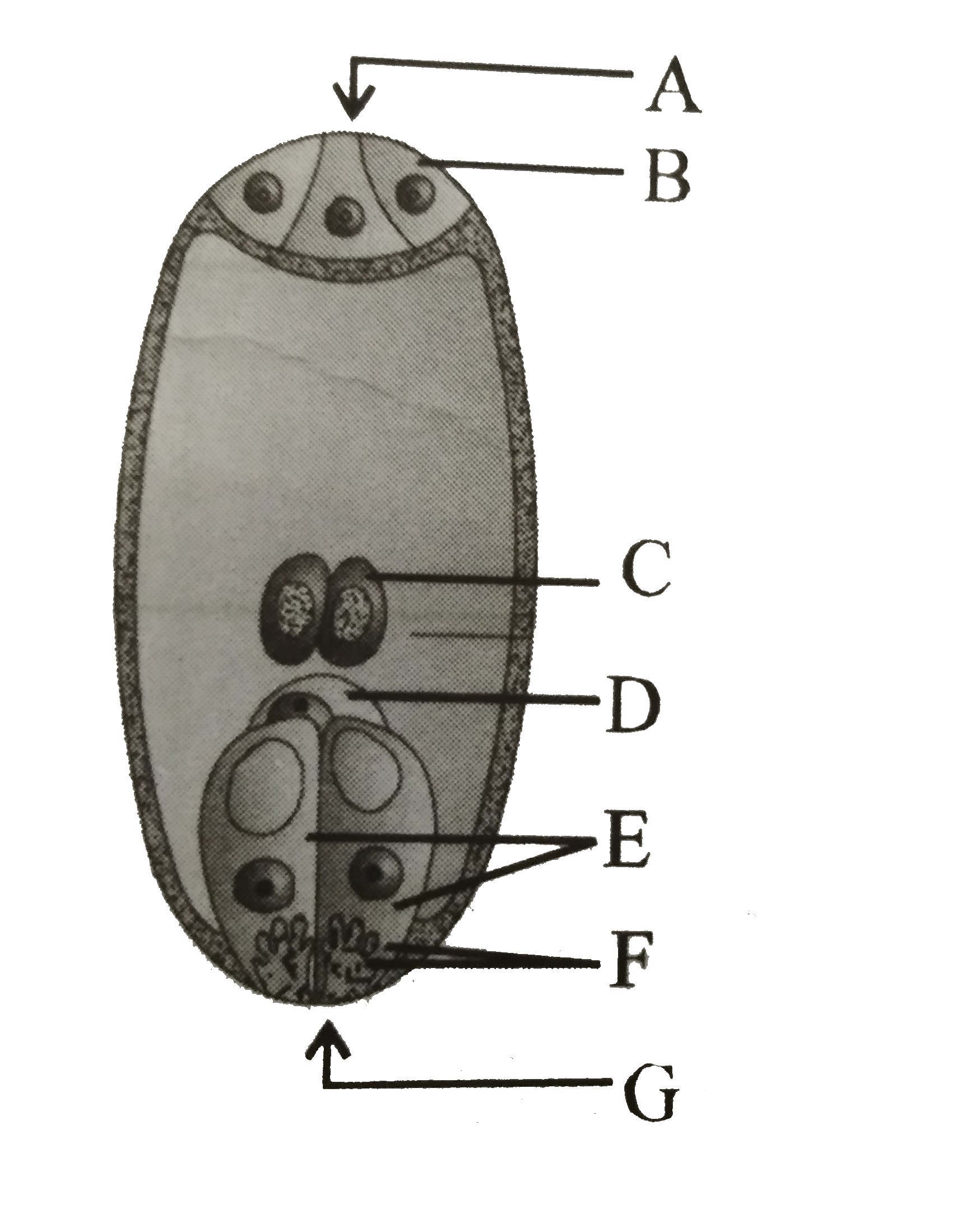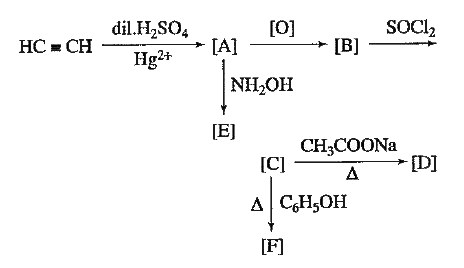CaCO3 on heating gives a white solid (A) and a gas (B), (A) on heating with carbon gives a solid (C) and a gas (D), (C) on hydrolysis glves a gas (E) and a solid (F) Identify (A), (B), (C), (D) , (E) and (F) .
To solve the problem step by step, let's analyze the reactions involving calcium carbonate (CaCO₃) and identify the substances formed at each stage.
Step 1: Heating of CaCO₃
When calcium carbonate (CaCO₃) is heated, it decomposes into two products:
- A white solid (A)
- A gas (B)
The reaction is:
CaCO3heat−−→CaO+CO2
From this reaction:
- (A) = Calcium oxide (CaO)
- (B) = Carbon dioxide (CO₂)
Step 2: Heating A (CaO) with Carbon
Next, we take the solid A (CaO) and heat it with carbon. This reaction produces:
- A solid (C)
- A gas (D)
The reaction is:
CaO+3Cheat−−→CaC2+CO
From this reaction:
- (C) = Calcium carbide (CaC₂)
- (D) = Carbon monoxide (CO)
Step 3: Hydrolysis of C (CaC₂)
Now, we take the solid C (CaC₂) and perform hydrolysis (reaction with water). This produces:
- A gas (E)
- A solid (F)
The reaction is:
CaC2+2H2O→Ca(OH)2+C2H2
From this reaction:
- (E) = Acetylene (C₂H₂)
- (F) = Calcium hydroxide (Ca(OH)₂)
Summary of Identifications
Now, we can summarize the identified substances:
- (A) = Calcium oxide (CaO)
- (B) = Carbon dioxide (CO₂)
- (C) = Calcium carbide (CaC₂)
- (D) = Carbon monoxide (CO)
- (E) = Acetylene (C₂H₂)
- (F) = Calcium hydroxide (Ca(OH)₂)
Final Answer
- A = CaO
- B = CO₂
- C = CaC₂
- D = CO
- E = C₂H₂
- F = Ca(OH)₂
When calcium carbonate (CaCO₃) is heated, it decomposes into two products:
- A white solid (A)
- A gas (B)
CaCO3heat−−→CaO+CO2
- (A) = Calcium oxide (CaO)
- (B) = Carbon dioxide (CO₂)
Next, we take the solid A (CaO) and heat it with carbon. This reaction produces:
- A solid (C)
- A gas (D)
CaO+3Cheat−−→CaC2+CO
- (C) = Calcium carbide (CaC₂)
- (D) = Carbon monoxide (CO)
Now, we take the solid C (CaC₂) and perform hydrolysis (reaction with water). This produces:
- A gas (E)
- A solid (F)
CaC2+2H2O→Ca(OH)2+C2H2
- (E) = Acetylene (C₂H₂)
- (F) = Calcium hydroxide (Ca(OH)₂)
Now, we can summarize the identified substances:
- (A) = Calcium oxide (CaO)
- (B) = Carbon dioxide (CO₂)
- (C) = Calcium carbide (CaC₂)
- (D) = Carbon monoxide (CO)
- (E) = Acetylene (C₂H₂)
- (F) = Calcium hydroxide (Ca(OH)₂)
- A = CaO
- B = CO₂
- C = CaC₂
- D = CO
- E = C₂H₂
- F = Ca(OH)₂
Topper's Solved these Questions
- BOOK - CENGAGE CHEMISTRY ENGLISHCHAPTER - P-BLOCK GROUP 14 - CARBON FAMILYEXERCISE - Ex (Subjective)21videos
P-BLOCK GROUP 14 - CARBON FAMILY
- BOOK - CENGAGE CHEMISTRY ENGLISHCHAPTER - P-BLOCK GROUP 14 - CARBON FAMILYEXERCISE - Ex (Objective)19videos
P-BLOCK GROUP 14 - CARBON FAMILY
- BOOK - CENGAGE CHEMISTRY ENGLISHCHAPTER - P-BLOCK GROUP 14 - CARBON FAMILYEXERCISE - Exercises Archives (Subjective)9videos
P-BLOCK GROUP 14 - CARBON FAMILY
- BOOK - CENGAGE CHEMISTRY ENGLISHCHAPTER - P-BLOCK GROUP 13 - BORON FAMILYEXERCISE - Exercise Archives (Subjecive)9videos
P-BLOCK GROUP 13 - BORON FAMILY
- BOOK - CENGAGE CHEMISTRY ENGLISHCHAPTER - PERIODIC CLASSIFICATION OF ELEMENTS AND GENERAL INORGANIC CHEMISTRYEXERCISE - Exercises (Archives )Subjective4videos
PERIODIC CLASSIFICATION OF ELEMENTS AND GENERAL INORGANIC CHEMISTRY
Similar Questions

Identify A, B, C, D, E, F,GView SolutionIdentify the compounds A, B, C, D, E and F.
 View Solution
View SolutionZinc on reaction with NaOH gives a salt (A) along with a gas (B).
(A) on reaction with H2S gas gives a white precipitate (C ).
Identify (A), (B) and (C ).View SolutionOixalic acid on stragheating gives (A) and (B) which are gaseous prouct and ( C) which is a liwue . Gas (B) turns lime water miky. Gas (A) on reaction with chlorine gas gives (D) . (D)m as wll as (B) on heating with ammonia gas gives the same produce ( E) . Identify (A) ,(B), ( C), (D) and ( E).
View SolutionMagnesium on heating in air gives (A) and (B). On reaction with water (B) gives a colourless gas (C).(C) when passed through CuSO4 solution, gives a blue coloured solution (D). Identify (C)
and (D).View Solutionalkali metal (A) on flame test gives a crimson red colour to the
Bunsen flame. (A) on heating in air gives compound (B), and (B)
further on hydrolysis gives (C ) and gas (D). Gas (D) with Nessler's reagent gives a brown precipitate Identify (A),
(B), (C ) and (D).View SolutionIdentify the compounds A, B, C, D, E and F:∗∗
 View Solution
View SolutionCalcium imide on hydrolysis will give gas (B) which on oxidation by beaching powder gives gas (C) gas (C) on reaction with magnesium give compound (D). (D) on hydrolysis gives gas (B). (B),(C) and (D) are
View SolutionAn inorganic red coloured compound (A) on heating gives a compound (B) and a gas (C). (A) on treatment with dil. HNO3 gives compound (D), brown colour substnace (E) and a neutral oxide (F). Compound (D) on warming gives off again gas (C). Then, (E) will be
View SolutionA black mineral (A) on heating in presence of air gives a gas (B). The mineral (A) on reaction with dilute H2SO4 gives a gas (C) and a solution of a compound (D) on passing the gas (C) into an aqueous solution of (B), a white turbidity is obtained. The aqueous solution of (D) on reaction with potassium ferricyanide gives a blue compound (E). Identify (A) to (E) and give chemical equations for the reaction involved.
View Solution

